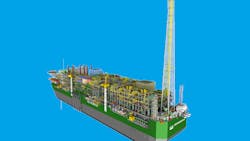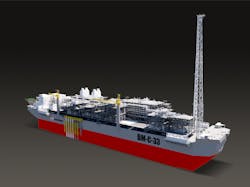Editor's note: This cover story first appeared in the September/October 2023 issue of Offshore magazine. Click here to view the full issue.
By Bruce Beaubouef, Managing EditorWith the worldwide mandate for emissions reduction, operators are urgently looking for ways to ‘green’ their production platforms. A particular focus is being placed on new and upcoming FPSOs scheduled for deployment offshore Brazil.
Some of the most promising paths toward that result include a re-examination of power generation technologies, and here operators are looking to “electrify” their systems through the use of combined-cycle power systems, and the replacement of gas turbines with all-electric drives and motors. And in some cases, they are actually upsizing their gas turbines to achieve greater efficiencies, thereby lowering emissions.
Traditionally, the offshore E&P industry has used open cycle gas turbines due to their simplicity of operation, low weight/compact footprint, and long history of successful use. But many of these turbines, especially the older ones, are a source of significant carbon emissions. A large portion of the energy consumed on an FPSO is typically supplied by associated gas, which is either consumed by the gas turbines for power generation or for mechanical drives; or compressed for processing, export, or re-injection purposes. All these systems present opportunities for emissions reductions. But power generation alone typically represents the source of more than 60% of the carbon emissions on recent-generation FPSOs, and thus provides the largest opportunities for emissions reduction.
Broadly, the strategy to reduce emissions on new and upcoming FPSOs can be divided into three strategies. One is to adopt larger and more efficient gas turbines, thus increasing topside power density and reducing footprint. This option can provide both economic as well as environmental benefits. The second option is to deploy electrically driven motor compressors as an alternative to (older) gas turbine-driven compressors, which also helps to reduce emissions while also improving power density. These two options can be combined with combined cycle gas turbines, which can bring further efficiencies and help reduce lifecycle costs under certain conditions. Full electrification of FPSOs will likely focus heavily on the use of combined cycle power generation technologies.
To study these options, a team at Baker Hughes recently developed a lifecycle cost analysis model to compare alternative configurations for both power generation and compression requirements on a typical large size FPSO (220 kbbl/d, 87 MW power demand). The model took into account both the carbon footprint/carbon prices, as well as economic considerations, namely fuel gas costs. The results, as described in the paper OTC-32513, showed that carbon emissions can be reduced by ~20% when moving from an open cycle to a combined cycle power generation system. The study also found that larger and more efficient gas turbines (>40 MW ISO) bring further benefits, namely a greater than 10% savings in overall cost, especially when compared to open cycle efficiencies.
Baker Hughes will have the opportunity to put some of these design initiatives into effect offshore Brazil. It recently won a contract from MODEC to provide combined cycle technology for the FPSO on Equinor’s BM-C-33 project, located in the presalt Campos basin. The new technology is expected to reduce the project’s carbon footprint.
The order comprises turbomachinery equipment, including LM2500 gas turbine generators and steam turbine generator technology, for a combined cycle power generation solution to be installed on the BM-C-33 FPSO. Equinor awarded a lump sum turnkey contract to MODEC for engineering, procurement, construction and installation activities this past May. It has an expected delivery date of 2027.
For this FPSO, Baker Hughes expects a more than 20% carbon emissions reduction versus similar FPSOs with open cycle gas turbine systems, with the same power demand. This is the second combined cycle power generation FPSO project developed by Baker Hughes for MODEC and Equinor in Brazilian deep waters, following the award for the Bacalhau FPSO in 2020.
For the BM-C-33 project, Equinor and its partners expect the FPSO to be able to achieve a carbon intensity target of less than 6 kg/boe over the field’s lifetime, while the global industry average is 16 kg CO2 per barrel.
Petrobras also has plans to electrify at least two of its upcoming FPSOs. At the recent OTC in Houston, company officials presented their plans to move towards an all-electric FPSO concept, starting with its upcoming P-84 and P-85 FPSOs. These FPSOs will be deployed at its Atapu 2 (P-84) and Sépia 2 (P-85) fields in the Santos basin. The two platforms will have a standardized design, with each having a production capacity of 225,000 bbl/d of oil and gas processing capacity of 10 MMcm/d.
Most notably, the FPSOs’ standardized design will include Petrobras’ all-electric concept, which relies heavily on driving all rotating equipment with electric motors—a first for FPSOs of this large size, offshore Brazil. The idea behind this concept is to have a single energy center in each forthcoming FPSO that will be about 60% larger than those installed in existing floaters. Company officials say that the FPSOs’ design incorporates more efficient power generation systems and fully optimized process plant equipment, and thus represents a key step forward in platform emissions reduction technology. Importantly, Petrobras officials said that these designs will not only reduce emissions but also increase production from the presalt regions, and thereby boost the value of these reserves.
The two FPSOs will also incorporate other emissions reduction systems and technologies, based on MACC (marginal abatement cost curve) methodology and Petrobras’ own low-carbon strategy. Besides reducing emissions from power generation, that strategy is focusing on other typical FPSO emission sources such as flaring, venting and fugitive gases. Zero routine venting will be achieved by recovering vented gases from the cargo tanks and the processing plant. Zero routine flaring will be achieved through recovery of gases through a closed flare system. Other measures that will reduce emissions include the use of variable speed drives for the pumps and compressors; valves designed for low fugitive emissions; and capture, use and subsurface storage of CO2 from the produced gas.
Petrobras says that many of these emissions-reducing designs will be firsts for large-capacity FPSOs of this size. That includes not only the all-electric plant concept, but also deeper seawater intake systems; gas blanketing for cargo tanks; and variable speed control on water injection pumps. As a result of these design changes, Petrobras says that the GHG emission intensity will be about 30% less than previous FPSO designs.
Two major construction shipyards – China Offshore Oil Engineering Corporation and Seatrium (the merged Sembcorp Marine/Keppel Offshore & Marine entity) – are reportedly working on commercial proposals for the construction of the P-84 and P-85 FPSOs. The proposals were due to be delivered at the end of July. Both FPSOs are expected to be in place and in operation by 2028.
And, new FPSO designs are coming that promise even greater emissions reduction. At OTC, Malaysian engineering group MISC premiered its newbuild MMEGA FPSO design, which it says has the potential to cut typical CO2 emissions by almost 40%.
The MMEGA design is based on fifth-generation FPSOs for deepwater and ultradeepwater fields, and is said to provide a high-production capacity and longer field life—up to 35 years, the company claims. The emissions reductions will come from the inclusion of a closed flare system teamed with combined cycle power generation; an all-electric drive system for compression; and gas reinjection.
The spread-moored MMEGA design comprises a double-sided single-bottom hull and can accommodate eight topsides mega-modules, with a riser balcony at the port side that can support up to 51 riser slots. Its topsides process and utility systems will be designed to handle 225,000 bbl/d of oil, 424 MMcf/d of gas, 250,000 bbl/d of water injection and treatment of up to 60 mol% CO2 in the wellstream. Oil storage capacity is 2 MMbbl, with offloading of 1 MMbbl feasible within 24 hours. The “Mega-Module” topsides design is said to minimize interfaces, also providing improved system integration. Other claimed benefits are a reduced overall engineering, procurement, construction, installation and commissioning schedule and optimized capex. MMEGA says that it has secured approval in principle (AiP) and the SUSTAIN -1 notation from ABS for this design.
About the Author
Bruce Beaubouef
Managing Editor
Bruce Beaubouef is Managing Editor for Offshore magazine. In that capacity, he plans and oversees content for the magazine; writes features on technologies and trends for the magazine; writes news updates for the website; creates and moderates topical webinars; and creates videos that focus on offshore oil and gas and renewable energies. Beaubouef has been in the oil and gas trade media for 25 years, starting out as Editor of Hart’s Pipeline Digest in 1998. From there, he went on to serve as Associate Editor for Pipe Line and Gas Industry for Gulf Publishing for four years before rejoining Hart Publications as Editor of PipeLine and Gas Technology in 2003. He joined Offshore magazine as Managing Editor in 2010, at that time owned by PennWell Corp. Beaubouef earned his Ph.D. at the University of Houston in 1997, and his dissertation was published in book form by Texas A&M University Press in September 2007 as The Strategic Petroleum Reserve: U.S. Energy Security and Oil Politics, 1975-2005.



